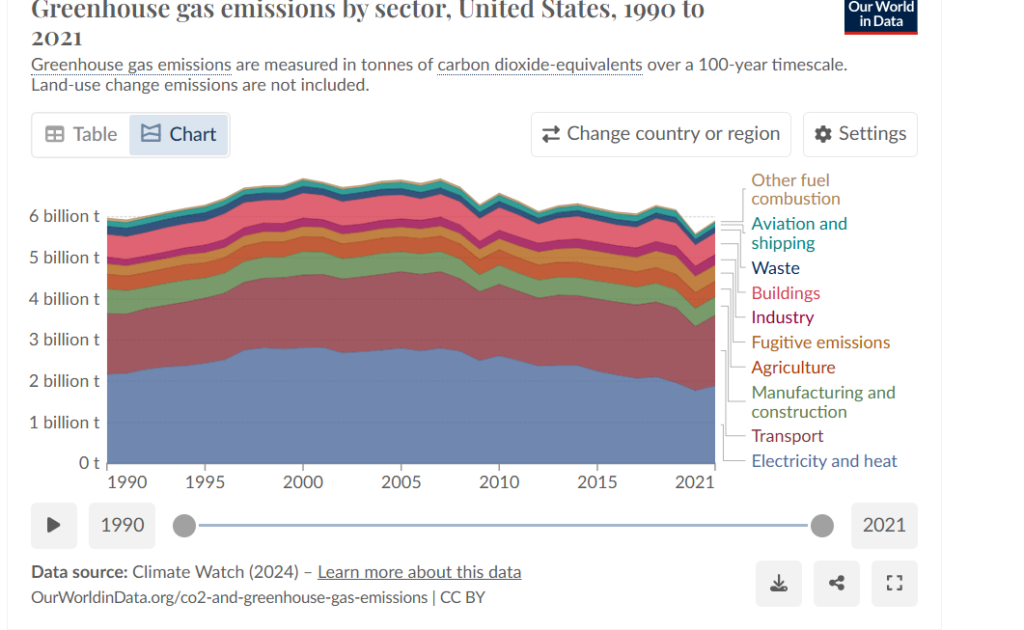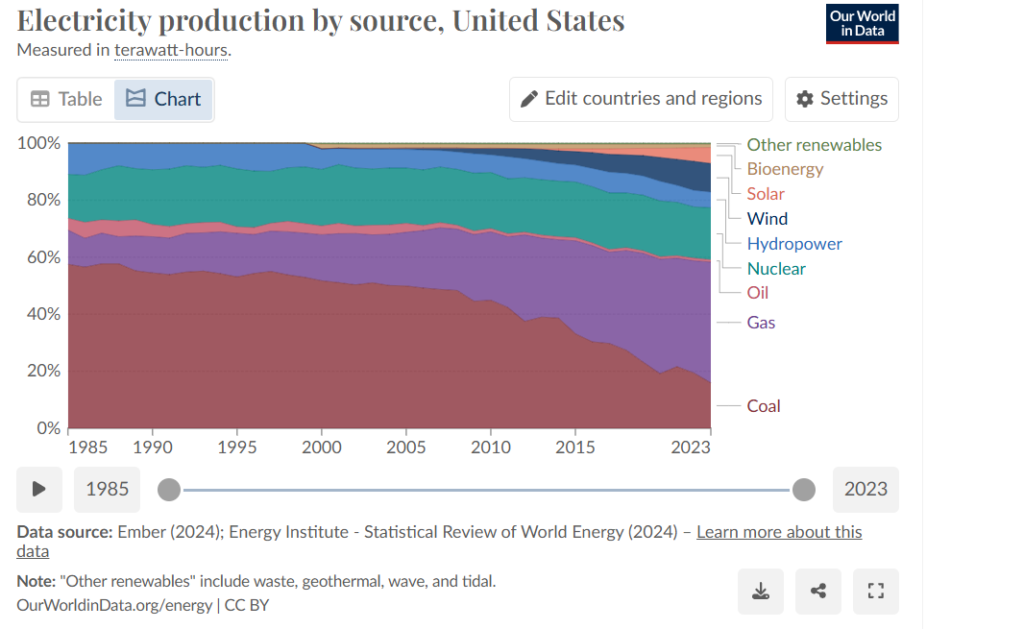Context – Countries – USA
Contents –
- GHG Emissions Profile
- Energy
- Energy, Environmental and Climate Policy in the US
- Climate Action Tracker Evaluation
- Recent Update Posts and News Links –
1. US GHG Emissions Profile
- The United States is the 2nd largest greenhouse gas emitter globally – pumping out 6 gigatonnes of CO2 equivalent (CO2e) in all green house gases in 2023 (WRI); representing approximately 11.25% of the global total (EU reports) .The gradual transition away from heavier carbon polluting sources of energy is indicated in the falling carbon intensity emissions per unit of energy; falling from 571g per kilowatt hour (kWh) in 2000 to 369g kWh in 2023.
- In what is fairly unique among countries, the transport sector has overtaken the electricity sector in the share of total carbon emissions in the country; 28% transport compared to 25% electricity; reflecting the gradual transition from coal to gas (a lower carbon intensity) and growth of renewable energy in electricity power production as well as the very large number of largely petrol driven motor vehicles per head of population. According to a recent article in Nature, US has in fact the largest passenger miles travelled per head in the world combined with low public transport usage and ‘a substantial fleet of aging and inefficient vehicles and heavy reliance on fossil fuels’ .
2. Energy
- US energy consumption by Sector is shown in the following graph. The large large GHG emissions for transport is reflected in the high and fairly consistent percentage of Oil: representing 41% of total fuel consumption (9300 TWh) in 1990 and still 38% (9,960 TWh) in 2023. Total GHGs emissions peaked around 2007 and have declined by about 20% as of 2023, driven by a cleaner energy mix, improved energy efficiency and by regulatory measures.

Electricity Production
- In terms of electricity production, the major development over the past 30 years is reflected in the significant shift from coal power to gas power production as may be seen in the graph below, representing 53% of electricity produced in 1990 but falling to 16% by 2023 as gas generation moved from 12.8% to 42% in the same period reflecting the revolution in shale gas production and making in same time the United States as the largest producer of natural (fossil) gas in the world.
- As the carbon emission intensity of gas is substantially lower than coal (200 vs 363kg CO2 per 1MWh), this switch in fuel source along with a growing but still relatively small contribution of clean renewable electricity is reflected in the reduced overall carbon intensity as noted earlier. This has all meant a reduction in the GHGs from electricity generation from 40% in 1990 to approximately 25% of the total in 2023. However the real challenge of today is to move away from fossil fuel based generation altogether to renewable sources.

Renewable Energy
- After a long period of slow growth, renewable energy in the past number of years and particularly since the introduction of the incentive package under the Inflation Reduction Act (IRA) in 2022 has shown strong growth with wind and solar combined from 2.33% share of total electricity production in 2010 to 15.61% in 2023 (10.01% wind, 5.6% solar) with most of that growth happening in the past few years with total annual electricity production increasing marginally in that time from 4114TWh to 4249TWh.
- Depending on the electrification of transport, heating and other industrial processes which are necessary to meet its carbon reduction commitments, the challenge for renewables will be to not only hold these percentage shares of overall generation in fast increasing demand scenario for electricity, especially when taking account of the particular challenges for renewables including the need for grid scale electricity storage and high upfront capital costs. This continued expansion of renewables would require ongoing incentives and the likely continuation of the IRA, which has been called into doubt by the recent return of the Republican President Donald Trump or the seperate States stepping up their renewables roll outs already happening including the largest renewables deployment in Texas, Trump supporting, oil producing state! [Update – July 2025 – Trump has largely rescinded the IRA subsidies in the ‘Big Beautiful Bill’ which has just passed through Congress]
3. Energy, Environmental and Climate Policy in the USA
- Over the past 50 years approximately, the US has introduced some key environmental and climate related legislation, often it has been noted during Republican presidencies such as Richard Nixon’s enactment of the pivotal Clean Air Act and Clean Water Act as well as the establishment of the EPA, together which have lead much of the recent regulation of standards for carbon emission control. Ronald Regan supported the Montreal Protocol to protect the ozone layer and banning of CFCs with huge global warming potentials, George W Bush who strengthened the Montreal Protocol and even Donald Trump who signed into law the Kigali Amendment which extended the Protocol and is estimated will avoid up to 0.5C of heating.
- Other important pieces of legislation included the American Recovery and Reinvestment Act 2009 which kick started investment in renewables after the banking crash and the landmark Inflation Reduction Act in 2022 which committed $369 billion to climate and clean energy investments with the aim to cut emissions by 40% from 2005 by 2030 [update July 2025 – now rescinded].
- It remains to be seen what impact the election of Donald Trump will have on this proud history of environmental protection and growing action on the climate. In his initial 3 months in office he has rolled back regulations on emissions, fuel economy standards and on methane emissions. He has also established a National Energy Dominance Council to actively promote oil and gas and has sought to restrict state-level climate change action as well as his intention to withdraw again from the Paris Agreement.
- Trump has also expressed concerns about the Inflation Reduction Act (IRA) in its support for clean energy funding programmes for both research and tax incentives for deployment however as an act of Congress, this would require amendment to revoke. As much of the funding has already been allocated to Republican leaning areas of the country it is not at all certain that he would succeed and Governors in Democratic held States have signalled their resistance to any Federal restriction on State climate policy action.
4. Climate Action Tracker Evaluation
- Each year the Climate Action Tracker evaluates the climate commitments of countries against a number of standards, the headlines one being the Countries alignment to the Paris Agreement goal of limiting global warming to well below 2 degrees and as close to 1.5 degrees as possible. The US is overall rated Insufficent which relates to the alignment with the 1.5 degrees Celsius heating target without drastic further emission reduction measures and this report was completed before Donald Trump won the presidential election in November 2024 which will further set back efforts in the country.
- The report also evaluates the likelihood of the achievement of the particular commitments of the country to reducing emission (Nationally Determined Commitment – ‘NDCs’). Current steps to achieve the US NDC to reduce emissions by 50%-52% below 2005 levels by 2030 have been rated ‘almost sufficient’ which means it could align with the 1.5C temperature limit with moderate improvements although again with the change in president, this is also likely to be lost.
- Other related US targets are evaluated in the 2024 report as follows:
- Net Zero Target – Average – transparent assumptions and comprehensive planning but several avenues to improve.
- Policies and Actions – Insufficient – current policies would meet a 2C warming target but not 1.5C.
- Climate Finance – Critically Insufficient – this takes account of the fair share contribution to international funding aid to less developed countries assistance for emissions reductions.
